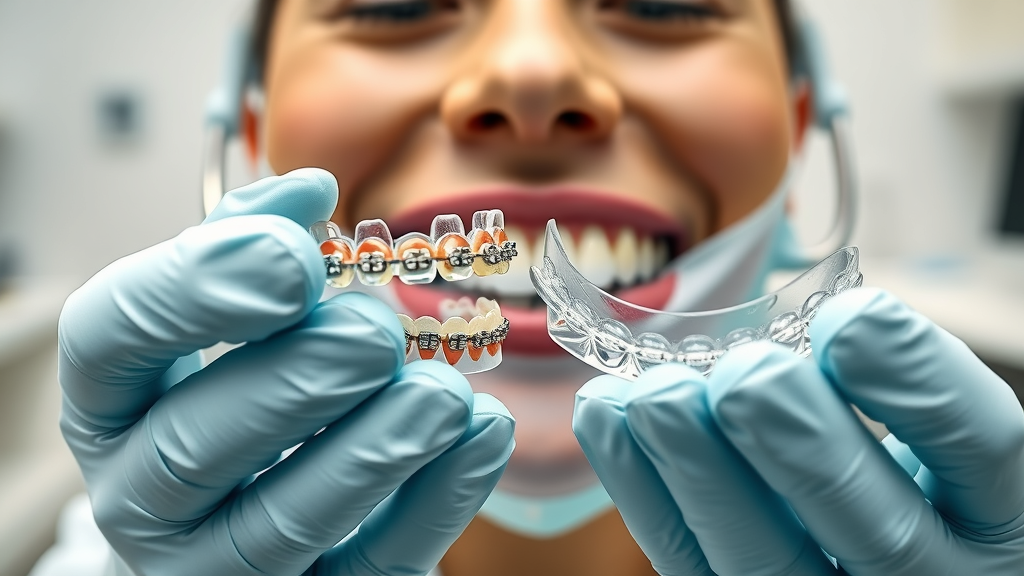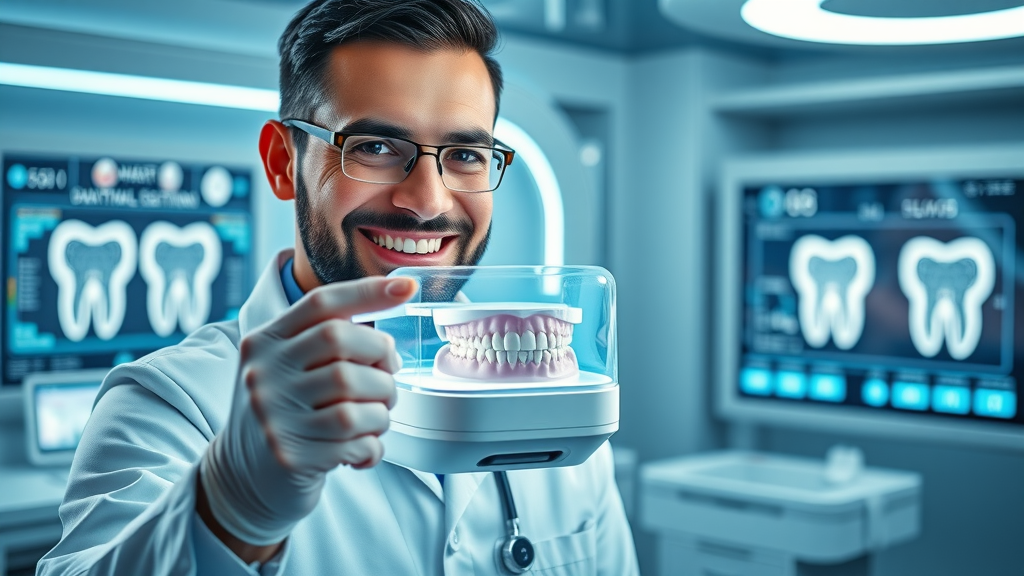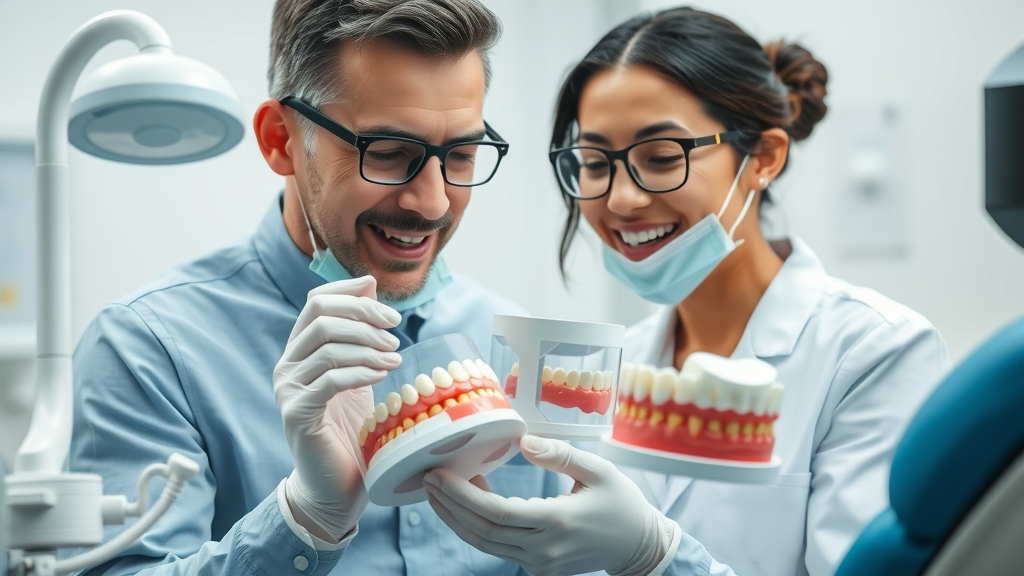Curious about why your dentist can clean your teeth but may refer you to an orthodontist for braces or jaw alignment? Unravel the mystery of these dental experts, and discover how choosing the right professional can transform not only your smile, but your overall oral health for life.
Unveiling the Difference: What Does an Orthodontist Do That a Regular Dentist Doesn’t?
“Not all oral health professionals are the same—discover why choosing between a dentist and an orthodontist can make or break your smile’s future.”
When it comes to oral health , many people wonder, what does an orthodontist do that a regular dentist doesn’t? The answer lies in their distinctive focus and specialized skill sets. While both are integral to maintaining a healthy smile, their roles diverge significantly beyond routine dental care.
A general dentist is your primary dental care provider, handling routine checkups, tooth decay treatment, gum disease prevention, and restorative procedures—think fillings, crowns, and extractions. Their main goal is to keep your teeth and gums healthy and address general dental issues. Meanwhile, orthodontists are dentists who have undergone extensive extra training to become dental experts in diagnosing and treating complex alignment issues , bite problems, and jaw irregularities. They design and implement specialized treatment plans using devices like braces and clear aligners to move teeth and jaws for both functional improvement and cosmetic enhancement.
Defining the Focus: Roles of Dentists and Orthodontists in Oral Health
The key distinction between a dentist and an orthodontist is in their focus. General dentists provide a wide range of services—from preventive cleanings to emergency dental care and restorative treatments. Their expertise lies in identifying disease and managing tooth and gum health. They’re the dental professional you’ll visit for cavities, root canals, and general oral maintenance, critical for preventing gum disease and protecting your healthy smile.
Orthodontic care , on the other hand, hones in on alignment. An orthodontist specializes in correcting crooked teeth , overbites , malocclusions , and other jaw discrepancies. By leveraging advanced orthodontic services, they diagnose bite problems, provide specialized treatment options, and offer orthodontic appliances designed specifically for unique patient needs. Their expertise leads to truly beautiful smile outcomes, working in tandem with your general dentist for comprehensive care.

-
General dentist: Primary dental care, routine checkups, oral health maintenance
-
Orthodontist: Specialist in bite, jaw alignment, and orthodontic treatment
Educational Pathways: Training of Dentists and Orthodontists
It’s often said that orthodontists are dentists , but not all dentists become orthodontists. The educational journey makes all the difference. A general dentist completes an undergraduate degree followed by four years of dental school , earning a DDS or DMD degree. After graduation, they can practice general dentistry, providing a wide range of essential oral health services.
Orthodontists take a further leap—they must be accepted into a highly competitive specialized residency in orthodontics, lasting an additional two to three years. Here, they master the intricacies of bite problems , jaw growth, and advanced orthodontic treatment, learning to use both traditional metal braces and modern clear aligners. Many also earn advanced certifications, solidifying their expertise. Only about 6% of dentists go on to become orthodontists—making their training truly distinctive in the world of dental care.
|
Comparison of Education |
General Dentist |
Orthodontist |
|---|---|---|
|
Dental School |
✔ |
✔ |
|
Specialized Residency |
|
✔ (Orthodontics, 2-3 years) |
|
Advanced Certifications |
Optional |
Often required |
Orthodontic Treatment: What Sets Orthodontists Apart from Dentists
What truly sets orthodontists apart is their ability to tackle the most complex orthodontic treatment cases. Their training focuses on diagnosing and creating treatment plans for alignment issues that extend far beyond what general dentists typically manage. Whether a patient struggles with malocclusions (improper bite), jaw misalignment, or requires advanced appliances, orthodontists provide the solutions necessary for ideal function and esthetics.
Unlike most general dentists—who may offer some basic orthodontic services—orthodontists have daily, hands-on experience with both common and highly involved cases. They utilize a combination of cutting-edge technology and precise diagnostics to achieve not only healthy smile but life-changing transformative results.
Diagnosis and Management of Complex Bite and Jaw Issues
Orthodontists excel at diagnosing and treating bite problems that can have lifelong effects if left unaddressed. Issues like crossbites , open bites , and overbites require clarity and advanced tools to identify subtle misalignments that a regular checkup might overlook. Correction of these problems not only improves the appearance of your smile but also safeguards against future dental complications such as abnormal wear, speech difficulties, and jaw pain.
The full scope of an orthodontist’s care includes functional and cosmetic adjustments—balancing your teeth and jaw for an integrated, confident, and comfortable bite. This often requires years of experience and insight gained only through advanced orthodontic training, which separates orthodontists and dentists in their approach to these cases.
-
Malocclusions
-
Crossbites
-
Open bites
-
Overbites
-
Functional and cosmetic adjustments

Creation of Tailored Orthodontic Treatment Plans
A hallmark of orthodontic care is the creation of a personalized treatment plan . The process begins with a comprehensive exam and the use of digital imaging —tools that allow orthodontists to see every angle of your teeth and jaw structure. Using this precise information, the orthodontist crafts a unique plan that outlines the optimal stages of treatment, monitors progress, and adapts strategies as your smile shifts.
Unlike the more general approach of routine dental care, orthodontic treatment requires meticulous ongoing oversight, ensuring optimal results at every phase. Orthodontists use their advanced training to tweak and tailor the process, from selecting the most suitable appliances to planning retention strategies after your beautiful smile has been achieved.
-
Comprehensive exam
-
Digital imaging
-
Customized treatment plan
-
Ongoing progress monitoring
Orthodontic Services Only Offered by Orthodontists
Certain orthodontic services are exclusively provided by orthodontists due to their specialized skills and advanced education. While a general dentist may handle minor alignment concerns or refer complex cases, orthodontists deliver a suite of services grounded in deep expertise and state-of-the-art technology. These include:
-
Braces application and management
-
Clear aligners (Invisalign, etc.)
-
Retainer design and monitoring
-
Jaw growth modification
-
Surgical orthodontics referral
Their proficiency in supervising challenging treatment options means patients can count on precise, reliable, and safe outcomes—backed by the American Association of Orthodontists and the association of orthodontists worldwide.

Clear Aligners vs. Traditional Braces: How Orthodontists Personalize Care
“An orthodontist’s expertise means your beautiful smile is crafted with a precision approach that a regular dentist’s training simply can’t match.”
Orthodontists now offer a spectrum of orthodontic treatment options, including both traditional metal braces and modern clear aligners like Invisalign. Patients seeking a less noticeable alignment solution often opt for clear aligners, while those with severe bite or jaw alignment issues may benefit from metal braces.
What makes a difference is not just the appliances themselves but the careful evaluation and insight an orthodontist brings to the table. Every treatment plan is custom-built, considering a patient’s individual facial structure, lifestyle, and desired results. This level of personalization isn’t typically found with general dentists, ensuring the most effective and esthetic route to a beautiful smile .
Dentists and Orthodontists: Overlapping and Distinct Services
Many people wonder about the overlap between dentists and orthodontists . While both dental professionals strive for optimal oral health , the scope and approach of their services differ. General dentists focus on broad dental care, including cleanings, cavity management, and restorative work. Orthodontists, on the other hand, deliver specialized care designed to correct alignment issues and optimize long-term dental function.
In some cases, their services intersect—such as basic orthodontic assessments or minor appliance maintenance. But for advanced alignment issues or complex bite problems, only orthodontists possess the training and hands-on experience needed for successful intervention.
|
Service |
General Dentist |
Orthodontist |
Overlap? |
Description |
|---|---|---|---|---|
|
Routine Exams |
✔ |
✔ |
Yes |
Basic oral checkups, disease screening |
|
Fillings & Crowns |
✔ |
|
No |
Tooth restoration and repair |
|
Braces & Aligners |
Limited |
✔ |
Some |
Comprehensive management of orthodontic appliances |
|
Jaw Growth Modification |
|
✔ |
No |
Advanced intervention for jaw development |
|
Surgical Orthodontics Referral |
|
✔ |
No |
Collaboration for severe alignment cases |
When to See a General Dentist vs. an Orthodontist
Knowing when to see a general dentist or an orthodontist is crucial for maintaining outstanding oral health and accessing the correct expertise.
-
Routine oral health exams
-
Cavity treatment
-
Emergency dental care
-
Specialty bite correction
-
Complex orthodontic cases
Generally, you’ll see your general dentist for preventive exams, gum disease care, and dental emergencies. But if you notice bite issues, crooked teeth, or persistent alignment problems, that’s when a specialized orthodontist steps in—ensuring you receive effective, long-lasting solutions.

Beautiful Smile Outcomes: The Role of Orthodontics in Long-Term Oral Health
A beautiful smile isn’t just an esthetic goal—it’s a crucial aspect of your overall oral and general health. With the guidance of a specialized orthodontist, patients benefit from far-reaching results that influence both function and confidence. Orthodontic care can prevent abnormal tooth wear, promote easier cleaning, improve jaw movement, and even resolve speech and chewing challenges.
-
Smile aesthetics
-
Jaw function improvement
-
Chewing and speech benefits
-
Oral hygiene ease
“A beautiful smile is more than straight teeth—it’s the harmony of your entire mouth, and that’s where orthodontists truly shine.”
People Also Ask: Orthodontists vs. Dentists—Your Top Questions Answered
What can an orthodontist do that a dentist can't?
-
Specialized diagnosis of jaw misalignment
-
Advanced orthodontic treatment (braces, appliances)
-
Coordinating surgical cases
Orthodontists are uniquely qualified through additional training to diagnose and manage severe jaw and alignment problems. They employ advanced orthodontic services and coordinate with other dental professionals for complex cases that may require surgery or intensive care.
Why see an orthodontist instead of a dentist?
-
For complex alignment, bite, and jaw issues
-
Expert guidance on long-term orthodontic care
If your dental needs extend beyond preventive care or basic restorations—such as persistent bite issues, crooked teeth, or jaw pain—seeing an orthodontist ensures you receive expert care designed for lasting results and a truly healthy, beautiful smile.
What is the difference between a general dentist and an orthodontist?
-
General maintenance vs specialized alignment
-
Level and focus of training
General dentists address a wide range of basic dental care needs, including cleanings and fillings, while orthodontists have specialized residency training in bite problems and teeth alignment, allowing them to offer advanced treatment plans focused on optimizing both appearance and function.
Why don't orthodontists remove teeth anymore?
-
Conservative philosophy
-
Evolution of orthodontic treatment
-
Use of advanced appliances to avoid extractions
Orthodontists now emphasize conservative, preservation-focused approaches. Thanks to advances in orthodontic appliances and treatment planning, most alignment problems can be resolved without extractions—preserving natural teeth whenever possible.
Orthodontic Treatment Innovations: Technology in Orthodontic Services
Advancements in dental technology have revolutionized the way orthodontists provide care. Today’s patients enjoy faster, more comfortable, and aesthetically pleasing options thanks to innovations such as digital imaging, clear aligners, remote monitoring, and personalized treatment planning. These technologies empower orthodontists to deliver precise results and minimize treatment times.
-
3D digital imaging
-
Clear aligners
-
Remote monitoring
-
Treatment plan customization

Watch a side-by-side comparison of today’s high-tech orthodontic tools such as clear aligners and remote monitoring versus traditional methods like metal braces and manual impressions. See how these innovations improve comfort, speed, and results for patients pursuing orthodontic care.
Coordinating Oral Health: How Dentists and Orthodontists Work Together
Your best path to a healthy smile is a collaborative one. Dentists and orthodontists regularly team up through patient referrals, shared care plans, and multidisciplinary strategies. While your general dentist manages ongoing oral health needs, an orthodontist steps in for specialized bite or alignment corrections. This teamwork results in a seamless patient experience, with optimal oral health outcomes.
-
Patient referrals
-
Collaborative care plans
-
Multidisciplinary approaches
Experience how dental experts coordinate care, from diagnosis to orthodontic treatment, for holistic patient outcomes.
Making the Choice: Deciding Between Dentists and Orthodontists for Orthodontic Treatment
Choosing the right dental professional for your orthodontic needs can feel overwhelming. Begin by assessing your specific needs—routine care versus alignment correction. Ask your general dentist about orthodontic services, and don’t hesitate to seek a referral for complex issues. Ultimately, consulting directly with an orthodontist ensures a treatment plan tailored specifically for your beautiful smile .
-
Assess your dental needs
-
Ask about orthodontic services
-
Consider referral to a specialized orthodontist
-
Seek a consultation for your treatment plan

Expert Perspectives: Why Professional Training Matters for Your Beautiful Smile
“An orthodontist’s extensive training is the reason for transformative results—trust the right credentials for the best outcome.”
Trusting your teeth and jaw alignment to a licensed orthodontic specialist ensures every treatment is backed by years of advanced training and clinical experience. For the best chance at a beautiful, long-lasting, and healthy smile, choose the dental professional with the credentials and commitment to excellence you deserve.
FAQs About What Does an Orthodontist Do That a Regular Dentist Doesn’t?
-
Q: Can a regular dentist fit braces?
A: While some general dentists offer limited orthodontic services, only trained orthodontists can address complex alignment and bite issues using a full range of modern appliances and techniques. -
Q: Is orthodontic treatment always necessary?
A: Not every patient requires orthodontics, but individuals with bite problems, jaw misalignment, or significant cosmetic concerns will greatly benefit from an orthodontist’s expertise and customized treatment plan. -
Q: Are orthodontic services covered by insurance?
A: Many dental insurance plans provide partial coverage for orthodontic treatment, especially for children. It’s important to review your policy details and consult with your provider for specifics.
Key Differences Recap: Dentist and an Orthodontist in Your Dental Health Journey
-
Scope of practice
-
Advanced orthodontic treatment
-
Impact on long-term oral health
-
Paths to a beautiful smile
Hear firsthand stories on how care from general dentists and orthodontists led to confident smiles, life-changing alignment, and improved oral health.
Ready to Elevate Your Smile? Get Trusted Guidance on What an Orthodontist Can Do For You
Want more expert-backed answers about braces, Invisalign, and local orthodontic care? Subscribe to Grand Strand Smile Spotlight and stay ahead of your smile journey.
When exploring the distinctions between dental professionals, it’s essential to understand the unique roles they play in oral health care. The article “Orthodontist vs. Dentist: What’s the Difference?” from Runnels Orthodontics provides a comprehensive overview of these differences, highlighting that while both dentists and orthodontists are integral to maintaining oral health, their areas of expertise diverge significantly. ( runnelsortho.com )
Similarly, the American Association of Orthodontists’ article “The Difference Between a Dentist and an Orthodontist” emphasizes that orthodontists undergo additional specialized training beyond dental school, focusing exclusively on diagnosing and treating misalignments of the teeth and jaws. ( aaoinfo.org )
For a more in-depth understanding of these roles and their impact on oral health, these resources offer valuable insights.
 Add Row
Add Row  Add
Add 




Write A Comment